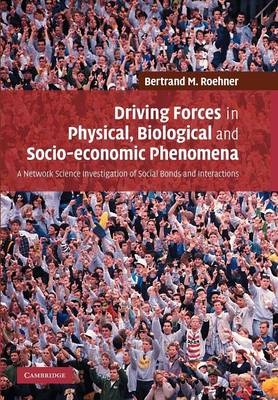
Driving Forces in Physical, Biological and Socio-economic Phenomena
A Network Science Investigation of Social Bonds and Interactions
Seiten
2012
Cambridge University Press (Verlag)
9781107411319 (ISBN)
Cambridge University Press (Verlag)
9781107411319 (ISBN)
In recent years network science has become a dynamic and promising discipline. This multi-disciplinary 2007 book explains how it is possible to bridge the gap between physics and sociology through network theory. It will be fascinating to graduate students and researchers in sociology and econophysics.
This book was first published in 2007. In recent years network science has become a dynamic and promising discipline; here it is extended to explore social and historical phenomena. While we experience social interactions every day, there is little quantitative knowledge on them. Instead we are often tempted to resort to fanciful explanations to explain social trends. Exogenous and endogenous interactions are often the key to understanding social phenomena and unravelling historical mysteries. This book begins by explaining how it is possible to bridge the gap between physics and sociology by exploring how network theory can apply to both. It then examines the macro- and micro-interactions in societies. The chapters are largely self-contained, allowing readers easily to access and understand the sections of most interest. This multi-disciplinary book will be fascinating to all physicists who have an interest in the human sciences and it will provide an alternative perspective to graduate students and researchers in sociology and econophysics.
This book was first published in 2007. In recent years network science has become a dynamic and promising discipline; here it is extended to explore social and historical phenomena. While we experience social interactions every day, there is little quantitative knowledge on them. Instead we are often tempted to resort to fanciful explanations to explain social trends. Exogenous and endogenous interactions are often the key to understanding social phenomena and unravelling historical mysteries. This book begins by explaining how it is possible to bridge the gap between physics and sociology by exploring how network theory can apply to both. It then examines the macro- and micro-interactions in societies. The chapters are largely self-contained, allowing readers easily to access and understand the sections of most interest. This multi-disciplinary book will be fascinating to all physicists who have an interest in the human sciences and it will provide an alternative perspective to graduate students and researchers in sociology and econophysics.
Preface; Part I. Bridging the Gap between Physics and the Social Sciences: 1. Probing bonds; 2. The battle against noise in physics; 3. The battle against noise in the social sciences; 4. Equilibrium and metastable states; 5. Are the data reliable?; Part II. Macro Interactions: Societies and States: 6. Shaping the zeitgeist; 7. Bonds of vassalage; 8. The absentee ownership syndrome; Part III. Micro Interactions: A Network View of Suicide: 9. Effects of male-female imbalance; 10. Effect of weakened marital bonds on suicide; 11. Effect of social isolation on suicide; 12. Apoptosis; 13. Perspectives; References; Index.
| Erscheint lt. Verlag | 25.10.2012 |
|---|---|
| Verlagsort | Cambridge |
| Sprache | englisch |
| Maße | 170 x 244 mm |
| Gewicht | 440 g |
| Themenwelt | Naturwissenschaften ► Physik / Astronomie |
| Sozialwissenschaften ► Soziologie ► Allgemeines / Lexika | |
| Wirtschaft ► Volkswirtschaftslehre ► Makroökonomie | |
| Wirtschaft ► Volkswirtschaftslehre ► Ökonometrie | |
| ISBN-13 | 9781107411319 / 9781107411319 |
| Zustand | Neuware |
| Informationen gemäß Produktsicherheitsverordnung (GPSR) | |
| Haben Sie eine Frage zum Produkt? |
Mehr entdecken
aus dem Bereich
aus dem Bereich
Gebundene Ausgabe 2025
Buch | Hardcover (2025)
C.H.Beck (Verlag)
CHF 68,60
Buch | Softcover (2024)
Phillip Reclam (Verlag)
CHF 17,90


